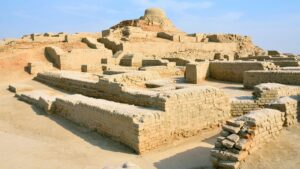CM M.K. Stalin Announces $1 Million Prize to Decipher Indus Valley Script
On January 5, 2025, during the centenary celebration of the Indus Valley Civilization’s discovery, Tamil Nadu Chief Minister M.K. Stalin made a significant announcement. He revealed a $1 million prize for individuals or organizations who successfully decode the ancient Indus Valley script, unlocking its meaning for global understanding. This initiative aims to encourage further research into the mysterious script of one of the world’s oldest and most advanced ancient civilizations.
What is the Indus Valley Civilization? 
The Indus Valley Civilization (IVC), also known as the Harappan Civilization, flourished between 3300 BCE to 1300 BCE in the northwestern regions of the Indian subcontinent. It is one of the world’s earliest urban societies, alongside ancient Egypt and Mesopotamia, with major settlements in present-day Pakistan and parts of India (mainly in the states of Punjab, Sindh, Gujarat, and Rajasthan). The Indus Valley is famous for its advanced urban planning, architecture, and sophisticated drainage systems.
Achievements of the Indus Valley Civilization:
- Advanced Urban Planning: The cities of the Indus Valley, such as Harappa and Mohenjo-Daro, were designed with remarkable foresight. Streets were laid out in grid patterns, and homes were built with standardized bricks, indicating a high degree of urban planning.
- The Drainage System: The Indus Valley Civilization is noted for its advanced drainage systems. Cities had well-organized sewage systems, with drains running along every street, a technological marvel for its time.
- Craftsmanship and Trade: The civilization was skilled in metalwork, pottery, and bead-making. Indus Valley inhabitants engaged in trade across the region, including with Mesopotamia. Evidence of seals, typically carved with animal motifs, have been found in both regions, further suggesting robust trade relationships.
- Writing System: The Indus Valley script, found on seals and pottery, remains undeciphered. It is one of the key reasons the civilization’s culture, beliefs, and society remain shrouded in mystery. Experts believe that the script might be a form of pictographic writing, with over 400 unique symbols. However, attempts to decode the script have yet to succeed.
- Agriculture and Economy: The Indus Valley people were primarily agrarian, growing crops like wheat, barley, and cotton, along with raising animals like cattle, buffaloes, and sheep. They also engaged in farming and fishing to support their economy.
Tamil Nadu’s Role in Decoding the Indus Valley Script
Tamil Nadu has played a pivotal role in exploring the connections between the Indus Valley Civilization and Tamil culture. During his announcement, CM Stalin emphasized that the Indus script shares striking similarities with ancient Tamil scripts, which further bolsters the idea of cultural continuity between the two regions.
The $1 million prize is designed to encourage researchers, particularly Tamil linguists, epigraphists, and archaeologists, to continue their efforts in decoding the Indus Valley script. Stalin also noted the research conducted by renowned scholars who have found parallels between the Indus script and Tamil graffiti marks. In fact, around 60% of the graffiti marks found in Tamil Nadu show significant resemblances to those used in Indus seals, underlining the deep historical connections between these ancient cultures.
The Importance of Sir John Marshall’s Discovery
The discovery of the Indus Valley Civilization by Sir John Marshall in 1925 was a pivotal moment in history. Marshall’s discovery challenged many long-standing beliefs about the origins of civilization in the Indian subcontinent. He proposed that the Indus Valley Civilization predated the Aryan Civilization and that the language spoken in the Indus Valley might have been related to Dravidian languages. This theory provided a new understanding of ancient India’s cultural and linguistic landscape, including the possible roots of modern-day Tamil.
The Tamil Nadu Chief Minister further referenced the importance of symbols like bulls, which are found both in the Indus Valley and Tamil Nadu. The bull has significant symbolic meaning in Tamil culture, especially in practices like Jallikattu (bull taming) in Alanganallur, Tamil Nadu. The connection between these cultural symbols strengthens the idea that the Dravidian culture may have been prevalent in the Indus Valley long before the rise of the Aryan civilization.
Key Developments Announced:
- $1 Million Prize: To encourage the global effort to decipher the Indus Valley script, Tamil Nadu’s government has committed a $1 million prize for those who succeed in unlocking its mysteries.
- ₹2 Crore Grant for Research: CM Stalin also announced a ₹2-crore grant for the creation of a research chair in the name of Iravatham Mahadevan, a distinguished archaeologist and epigraphist. This will promote continued research into the Indus Valley Civilization at the Indus Research Centre in Chennai.
Conclusion: Unraveling the Mysteries of the Indus Valley Civilization
The Indus Valley Civilization is one of humanity’s most important ancient cultures, yet its script remains an enduring mystery. Tamil Nadu’s initiatives, including the $1 million prize and research grants, aim to bring the world closer to understanding this enigmatic civilization. By fostering research and collaboration, Tamil Nadu is setting the stage for groundbreaking discoveries that could redefine our understanding of ancient Indian culture, particularly the roots of Dravidian languages and their role in shaping modern Tamil identity. The discovery of the Indus script’s meaning may well unlock the secrets of an ancient civilization that predated much of the world’s known history.

Pingback: “1964 Hindu Marriage Act Amendment: Transforming Women’s Rights in India”